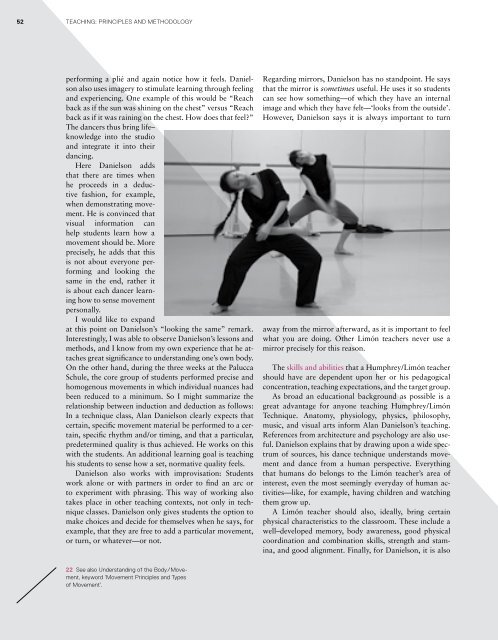Dance Techniques 2010
What does today's contemporary dance training look like? Seven research teams at well known European dance universities have tackled this question by working with and querying some of contemporary dance s most important teachers: Alan Danielson, Humphrey/Limón Tradition, Anouk van Dijk, Countertechnique, Barbara Passow, Jooss Leeder Technique, Daniel Roberts Cunningham Technique, Gill Clarke Minding Motion, Jennifer Muller Muller Technique, Lance Gries Release and Alignment Oriented Techniques. This comprehensive study includes interviews, scholarly contributions, and supplementary essays, as well as video recordings and lesson plans. It provides a comparative look into historical contexts, movement characteristics, concepts, and teaching methods. A workbook with two training DVDs for anyone involved in dance practice and theory. Ingo Diehl, Friederike Lampert (Eds.), Dance Techniques 2010 – Tanzplan Germany. With two DVDs. Berlin: Henschel 2011. ISBN 978-3-89487-689-0 (Englisch) Out of print.
What does today's contemporary dance training look like? Seven research teams at well known European dance universities have tackled this question by working with and querying some of contemporary dance s most important teachers: Alan Danielson, Humphrey/Limón Tradition, Anouk van Dijk, Countertechnique, Barbara Passow, Jooss Leeder Technique, Daniel Roberts Cunningham Technique, Gill Clarke Minding Motion, Jennifer Muller Muller Technique, Lance Gries Release and Alignment Oriented Techniques.
This comprehensive study includes interviews, scholarly contributions, and supplementary essays, as well as video recordings and lesson plans. It provides a comparative look into historical contexts, movement characteristics, concepts, and teaching methods. A workbook with two training DVDs for anyone involved in dance practice and theory.
Ingo Diehl, Friederike Lampert (Eds.), Dance Techniques 2010 – Tanzplan Germany. With two DVDs. Berlin: Henschel 2011. ISBN 978-3-89487-689-0 (Englisch) Out of print.
You also want an ePaper? Increase the reach of your titles
YUMPU automatically turns print PDFs into web optimized ePapers that Google loves.
52<br />
Teaching: Principles and Methodology<br />
performing a plié and again notice how it feels. Danielson<br />
also uses imagery to stimulate learning through feeling<br />
and experiencing. One example of this would be “Reach<br />
back as if the sun was shining on the chest” versus “Reach<br />
back as if it was raining on the chest. How does that feel?”<br />
The dancers thus bring life–<br />
knowledge into the studio<br />
and integrate it into their<br />
dancing.<br />
Here Danielson adds<br />
that there are times when<br />
he proceeds in a deductive<br />
fashion, for example,<br />
when demonstrating movement.<br />
He is convinced that<br />
visual information can<br />
help students learn how a<br />
movement should be. More<br />
precisely, he adds that this<br />
is not about everyone performing<br />
and looking the<br />
same in the end, rather it<br />
is about each dancer learning<br />
how to sense movement<br />
personally.<br />
I would like to expand<br />
at this point on Danielson’s “looking the same” remark.<br />
Interestingly, I was able to observe Danielson’s lessons and<br />
methods, and I know from my own experience that he attaches<br />
great significance to understanding one’s own body.<br />
On the other hand, during the three weeks at the Palucca<br />
Schule, the core group of students performed precise and<br />
homogenous movements in which individual nuances had<br />
been reduced to a minimum. So I might summarize the<br />
relationship between induction and deduction as follows:<br />
In a technique class, Alan Danielson clearly expects that<br />
certain, specific movement material be performed to a certain,<br />
specific rhythm and / or timing, and that a particular,<br />
predetermined quality is thus achieved. He works on this<br />
with the students. An additional learning goal is teaching<br />
his students to sense how a set, normative quality feels.<br />
Danielson also works with improvisation: Students<br />
work alone or with partners in order to find an arc or<br />
to experiment with phrasing. This way of working also<br />
takes place in other teaching contexts, not only in technique<br />
classes. Danielson only gives students the option to<br />
make choices and decide for themselves when he says, for<br />
example, that they are free to add a particular movement,<br />
or turn, or whatever—or not.<br />
Regarding mirrors, Danielson has no standpoint. He says<br />
that the mirror is sometimes useful. He uses it so students<br />
can see how something—of which they have an internal<br />
image and which they have felt—‘looks from the outside’.<br />
However, Danielson says it is always important to turn<br />
away from the mirror afterward, as it is important to feel<br />
what you are doing. Other Limón teachers never use a<br />
mirror precisely for this reason.<br />
The skills and abilities that a Humphrey / Limón teacher<br />
should have are dependent upon her or his pedagogical<br />
concentration, teaching expectations, and the target group.<br />
As broad an educational background as possible is a<br />
great advantage for anyone teaching Humphrey / Limón<br />
Technique. Anatomy, physiology, physics, philosophy,<br />
music, and visual arts inform Alan Danielson’s teaching.<br />
References from architecture and psychology are also useful.<br />
Danielson explains that by drawing upon a wide spectrum<br />
of sources, his dance technique understands movement<br />
and dance from a human perspective. Everything<br />
that humans do belongs to the Limón teacher’s area of<br />
interest, even the most seemingly everyday of human activities—like,<br />
for example, having children and watching<br />
them grow up.<br />
A Limón teacher should also, ideally, bring certain<br />
physical characteristics to the classroom. These include a<br />
well–developed memory, body awareness, good physical<br />
coordination and combination skills, strength and stamina,<br />
and good alignment. Finally, for Danielson, it is also<br />
22 See also Understanding of the Body / Movement,<br />
keyword ‘Movement Principles and Types<br />
of Movement’.


















